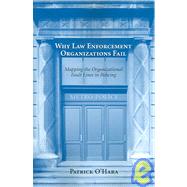
| Acknowledgments | xi | ||||
| Prologue Ordinary Disorder | 3 | (6) | |||
| Endnotes | 9 | (2) | |||
| Chapter One Diagnosing Organizational Dysfunction in Policing | 11 | (14) | |||
|
11 | (4) | |||
|
15 | (1) | |||
|
16 | (2) | |||
|
18 | (3) | |||
|
21 | (1) | |||
|
22 | (1) | |||
|
22 | (3) | |||
| Chapter Two Normal Accidents in Law Enforcement: Making Sense of Things Gone Wrong | 25 | (22) | |||
|
26 | (2) | |||
|
28 | (1) | |||
|
29 | (13) | |||
|
30 | (2) | |||
|
31 | (1) | |||
|
32 | (7) | |||
|
35 | (1) | |||
|
36 | (3) | |||
|
39 | (12) | |||
|
40 | (2) | |||
|
42 | (2) | |||
|
44 | (3) | |||
| Chapter Three Structural Failure in Law Enforcement: Design Defects in Organization | 47 | (42) | |||
|
47 | (1) | |||
|
48 | (2) | |||
|
50 | (1) | |||
|
51 | (32) | |||
|
52 | (15) | |||
|
57 | (1) | |||
|
58 | (2) | |||
|
60 | (4) | |||
|
64 | (3) | |||
|
67 | (5) | |||
|
67 | (1) | |||
|
68 | (1) | |||
|
69 | (3) | |||
|
72 | (17) | |||
|
77 | (3) | |||
|
80 | (3) | |||
|
83 | (2) | |||
|
85 | (4) | |||
| Chapter Four Oversight Failure in Law Enforcement: Marginalizing the Guardians | 89 | (26) | |||
|
89 | (22) | |||
|
91 | (8) | |||
|
94 | (2) | |||
|
96 | (3) | |||
|
99 | (9) | |||
|
102 | (2) | |||
|
104 | (2) | |||
|
106 | (2) | |||
|
108 | (9) | |||
|
109 | (2) | |||
|
111 | (1) | |||
|
111 | (4) | |||
| Chapter Five Cultural Deviation in Law Enforcement: Closed Worlds That Damage Agencies | 115 | (32) | |||
|
115 | (2) | |||
|
117 | (27) | |||
|
118 | (7) | |||
|
121 | (2) | |||
|
123 | (2) | |||
|
125 | (12) | |||
|
130 | (2) | |||
|
132 | (2) | |||
|
134 | (2) | |||
|
136 | (1) | |||
|
137 | (11) | |||
|
139 | (3) | |||
|
142 | (2) | |||
|
144 | (1) | |||
|
144 | (3) | |||
| Chapter Six Institutionalization in Law Enforcement: Running Agencies for Those Within | 147 | (34) | |||
|
148 | (27) | |||
|
152 | (9) | |||
|
155 | (1) | |||
|
156 | (3) | |||
|
159 | (2) | |||
|
161 | (8) | |||
|
164 | (2) | |||
|
166 | (3) | |||
|
169 | (14) | |||
|
174 | (1) | |||
|
175 | (3) | |||
|
178 | (3) | |||
| Chapter Seven Resource Diversion in Law Enforcement: Exploiting Organizational Systems | 181 | (26) | |||
|
181 | (2) | |||
|
183 | (20) | |||
|
184 | (6) | |||
|
187 | (3) | |||
|
190 | (7) | |||
|
191 | (2) | |||
|
193 | (1) | |||
|
194 | (2) | |||
|
196 | (1) | |||
|
197 | (12) | |||
|
199 | (2) | |||
|
201 | (1) | |||
|
202 | (1) | |||
|
203 | (1) | |||
|
204 | (3) | |||
| Epilogue Managing Imperfection | 207 | (10) | |||
|
209 | (4) | |||
|
211 | (2) | |||
|
213 | (2) | |||
|
215 | (2) | |||
| Bibliography | 217 | (6) | |||
| Index | 223 |
The New copy of this book will include any supplemental materials advertised. Please check the title of the book to determine if it should include any access cards, study guides, lab manuals, CDs, etc.
The Used, Rental and eBook copies of this book are not guaranteed to include any supplemental materials. Typically, only the book itself is included. This is true even if the title states it includes any access cards, study guides, lab manuals, CDs, etc.